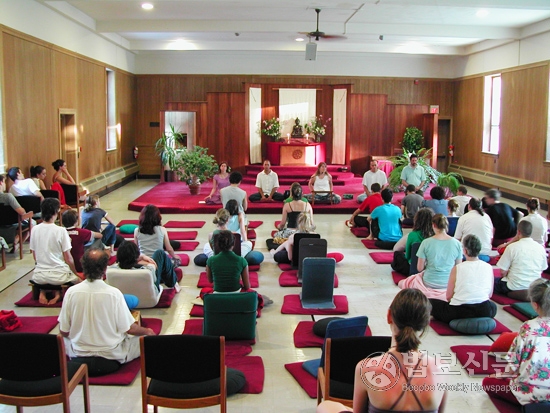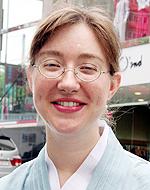정진 종료후 봉행하는 의식은 공동체의 공덕
수행의 성스러움과 신성함 깨닫게 하는 방편
|
지난 20년 동안 나는 미국 중부의 메사추세츠 주(州)에 있는 ‘통찰명상협회’(Insight Meditation Society)가 주관하는 안거와 명상수행에 참여해 왔다. 이 센터 또는 다른 서구의 위빠사나 수행센터에서 진행하는 안거 수행방식은 매우 단순하다. 선방에 들어가 45분 동안 좌선을 하고 종이 울리면 일어나 행선을 한다. 원하는 사람은 좌선 전후에 절을 해도 된다. 하지만 꼭 그렇게 해야 한다는 규칙은 없다. 절을 하는 사람도 있고 일부는 절을 하지 않는다. 절을 한다고 해서 동시에 같이 하는 것도 아니다. 독송을 하지도 않는다. 읽을 만한 경전은 아예 없다. 모든 것은 침묵 속에서 진행된다. 복장도 각자 원하는 대로 착용한다. 러닝셔츠나 팬츠, 원한다면 우스꽝스러운 모자까지도 허용된다. 명상을 할 때 동일한 방향을 향해 앉을 것, 정숙할 것, 수행 시간이 끝나기 전에 일어나지 않을 것 등이 지켜야 할 규칙이다. 공양과 울력, 법문, 일과의 시작과 종료, 그 외 일체의 일상은 지극히 개방적이고 자율적인 의식이나 형식이 적용된다.
이러한 형식의 단순성은 여러 가지 측면에서 매우 유용하다. 먼저 초심자들이라 할지라도 짧은 시간 안에 편안함을 느끼고 자신들이 따라야 할 관례가 있는지에 대해 더 이상 의식하지 않게 된다. 불교 사원의 환경에서 성장하지 않은 서구인들은 이러한 분위기에 크게 안도한다. 둘째로 많은 서구인들은 종교, 특히 그 의례적인 면에 대해 불편을 느끼곤 하는데 종교적인 형식이 없이도 영적인 삶을 발전시켜 나갈 수 있는 방법들을 자연스럽게 자기 것으로 수용하게 된다. 셋째로 이런 단순한 형태의 규율은 옷차림 등 준수해야 할 기타의 것들 보다는 명상수행 자체에 집중할 수 있도록 돕는다. 나는 지난 몇 해 동안은 이러한 형태의 이완된 수행공동체를 좋아했다. 나의 부모님이 속해 있었던 일본 조동종 계열에서는 비교적 세밀한 전례와 규범을 엄격하게 준수하면서 형식을 중시했었고 그런 환경 속에서 성장한 나는 이런 느슨한 형태의 의식이나 형식을 특히 선호하게 되었다.
6월 서구불교법사회의 중, 각기 다른 불교전통과 종파 출신의 법사들이 아침 명상수행을 지도했다. 하루는 틱낫한 스님이 이끄는 베트남 종단 출신의 비구 스님 두 분과 비구니 스님 두 분이 지도하는 명상수행에 참여했었다. 이들이 지도한 방법은 마음챙김 명상수행이었지만 형식은 대승불교의 전통을 따랐다. 좌선에 들기 전 좌복에서 감사의 절을 함께했다. 그리고 그 중 한 법사는 다음과 같은 게송을 염송했다.
여기에 앉아 있는 것은
마치 보리수 아래에서
자리하는 것과 같다네
내 몸은 마음챙김, 그 자체인걸
고요하고 편안하다네
온갖 번뇌를 놓으리
좌복에 앉자 ‘당 응이엠’ 자매는 안정되고 편안한 자세를 취할 수 있는 몇 가지 요령을 제시했다.
“좌선 수행을 함에 있어 그것이 힘든 일이 되어서는 안 됩니다. 좌선 수행은 환희여야 합니다.”
이윽고 지도법사들은 그들의 전통적인 새벽 종송(鍾頌)을 염송했다.
법신은 새벽빛을 쏟아내고
한 점에 모인 그 마음 평화롭고
입술은 엷은 미소 머금었네
새 날이구나!
마음챙김 종일토록 이어지길 다짐하네
이제 지혜의 태양 솟아올라 시방을 비추고 있네
거룩한 스님들 쉼 없이 명상에 빠져드네
나무 석가모니불!
우리는 45분가량 좌선을 했다. 명상이 종료될 무렵 종이 울렸다. 지도 법사들은 각자 자신의 발과 다리, 어깨 등을 주무르도록 해 편하게 일어날 수 있도록 배려했다. 몇 분 후 작은 종이 울렸고 우리는 선 채로 서로를 마주보았다. 수행과정에서 서로에게 도움을 준 것에 대해 감사를 표시하기 위해 맞절을 했다. 마지막으로 불단을 향해 우리의 수행 공덕을 회향하는 의미로 절을 했다.
이러한 과정을 거치면서 명상수행이란 개념에 약간의 형식이 필요하다는데 나의 심리작용이 동의하고 있었다.
그 첫째 이유로 일체성을 띤 의식을 함께 하면서 공동체의 원력(힘)을 느꼈다. 우리 모두가 함께 절을 할 때, 집단적인 표현이 공동체는 물론이요 나 자신에게도 커다란 에너지가 되었다. 어려운 수행과정에 나 홀로 뛰어든 것이 아니라, 여기에 몰두하는 동료들과 함께 있다는 것 자체가 수행력으로 승화되는 순간이었다.
둘째로 시작과 끝을 명확하게 구분하는 것이 명상수행 그 자체를 더 효율적으로 행하게 하는 체계가 된다는 사실을 깨닫게 되었다. 명상수행 전에 행하는 의식은 수행 의욕을 고취시키고 앞으로 행할 수행을 원만히 완성하고자 하는 결의를 되새기고 다지게 했다. 명상수행 종료 후 행하는 의식은 불성(佛性)을 밝히고자 하는 우리 공동의 공덕이 되고 선(善)이 된다는 것을 알아차리게 되었다.
결과적으로 침묵 속에서 행하는 좌선수행이 더욱 강렬하게 다가온다는 결론에 도달했다. 셋째로 형식 자체는 하나의 생활방식에서 또 다른 삶의 지혜나 방편으로 표출되는 자양분이 되기도 한다. 초기단계의 수행형식은 일상의 빠른 속도에서 조용한 명상수행 분위기로 전환하게 하는 효과적인 방법이 되었다. 마지막으로 그 형식은 고요하게 ‘앉아 있음’에서 몸의 활동을 우아하게 전환하는 수단이 된다. 마무리 부분은 특히 중요했다. 왜냐하면 그러한 형식은 고요히 좌선하면서 계발한 마음챙김 상태에 집중함으로써 더욱 공고해질 수 있기 때문이다. 마지막으로 그 의식은 성스러움과 신성함을 느끼게 했고 궁극적인 목적을 되새기게 했다. 바로 이러한 것들이야 말로 명상 정진의 노력을 훨씬 더 심오한 개념으로 깨닫게 해주는 증거이리라.
‘좌선이란 형식이 명상수행에 유용하다’는 나의 ‘발견’에 대해 한국 불자들은 비웃을 것이라 확신한다. 물론 한국의 사부대중은 1000년이 넘게 그 형식에 따라 수행하고 그것을 일상에서 활용해왔다. 그렇기 때문에 그러한 형식의 틀은 사찰에서의 수행관례에 완전히 일체화되었을 것이다. 그러나 처음에 그것이 왜 그곳에 있었는가를 알기 위해서는 때로는 그러한 형식의 틀이 없이 지내보는 것도 필요하다.
|
그런 측면에서 이제 나도 형식의 기능에 대해 긍정적으로 이해하게 되었다. 통찰명상협회가 그들의 방식을 조만간 바꿀 것이라고는 생각하지 않는다. 하지만 내가 법사의 길을 계속 가는데 있어서 함께 일하고 수행하는 공동체에 나는 더 많은 형식들을 도입하기 위해 노력할 것이라 믿어 의심치 않는다.
수미런던 듀크 불교공동체 지도법사 simplysumi@gmail.com
번역 백영일 위원 yipaik@wooribank.com
다음은 영문원고 전문.
Form is Form
For about twenty years now, I have been attending retreats and meditation sessions at the Insight Meditation Society in central Massachusetts. The way this center and many other vipassana centers in the West run retreats is pretty simple. You enter the meditation hall, you sit down for 45 minutes, and after the bell rings, you get up and go do some walking meditation. You can bow before and after the sit if you want to, but there's no expectation to do so. Some bow, some do not. Those that bow don't do it together. There's no chanting, either. Nothing to read. All in silence. You wear what you want to wear-tank top, shorts, a funny hat if you must. The only expectations are that you face the same direction, are quiet, and don't leave the meditation session early. The same lack of ritual or form applies to meals, work periods, dharma talks, the start and end of the day, and all else.
The simplicity of this style is hugely beneficial in several ways. First, beginners immediately feel comfortable and aren't self-conscious about whether there is a custom that they're doing right or wrong. For Westerners who aren't brought up in a Buddhist temple environment, this comes as a big relief. Second, since a lot of Westerners are uncomfortable with religion, particularly the ritual parts of religion, having a way of developing their spiritual life without a lot of religious form is very welcome. Third, the simple style keeps the focus on the meditation practice itself rather than on the accoutrements. I have loved this relaxed model for many years, and I especially welcomed it after being raised in the rather form-intensive style that my parents' Japanese Soto Zen community followed, with its relatively elaborate rituals and expectations.
During the conference in June, teachers from different lineages and schools led the morning meditation. One morning, I attended the meditation that was led by two nuns and two monks from Thich Nhat Hanh's Vietnamese order, which uses a mindfulness meditation practice but framed in the Mahayana tradition. Before we sat down, we took a moment to bow together to our cushion in gratitude. One of the monastics then recited this gatha:
"Sitting here is like sitting under the Bodhi Tree.
My body is mindfulness itself,
calm and at ease,
free from distraction."
After settling in on our cushions, Sister Dang Nghiem offered some guidance on how to establish an upright, stable, and relaxed posture. She may have said something to the effect of, "In our practice of sitting meditation, it should not be hard effort. Our sitting meditation needs to be a delight."
Then the monastics did their traditional morning bell chant:
The Dharmakaya is bringing morning light
In concentration, my heart is at peace
A half-smile is born upon our lips.
This is a new day, and I vow to go through it mindfulness
The Sun of Wisdom has now risen
And is shining in every direction
Noble Sangha diligently bring your mind into meditation.
Namo Shakyamunaye Buddhaya
We sat for about forty minutes. At the end of the period of sitting, the bell was invited. The monastics then had us massage our feet, legs and shoulders in preparation to stand up. After a minute or so, a small bell was invited and we stood up and faced each other, bowing to each other to express our gratitude to each other for supporting us in our practice. Finally, we turned to the altar and bowed to offer the merit.
I noticed something about my psychology with the addition of a small amount of form to the meditation. First and foremost, I felt the power of collective action. When we all bowed together, this communal expression gave me a feeling of great support. I was not plunging into this difficult practice alone but with dedicated friends. Second, I felt the clear marking of a beginning and an end provided a much nicer container for the meditation itself. The ritual before helped drum up energy and resolve for the task ahead. The ritual at the end of the meditation acknowledged that our collective effort to reveal Buddha nature was meritorious and good for the world. I felt my meditation practice during the silent, seated portion was much stronger as a result. Third, the form itself was an important way to transition from one mode of living to another. At the beginning, it was a way of transitioning from the high speed of daily work down to a quiet meditation. At the end, the form provided a way of gracefully shifting from quiet sitting to using the body. The ending was particularly important because the form allowed for the mindfulness cultivated during the still sitting to be extended into motion for as long as concentration would allow. Fourth and finally, the ritual generated a sense of the sacred, the holy, a reminder of the highest intentions, that really framed the meditative endeavor in much more profound terms.
I'm surely aware that you Korean Buddhists are laughing at my "discovery" that form is useful to meditation! Of course, you have been doing it for more than a thousand years, and form is deeply integral to the customs of a temple. But sometimes it takes dispensing with something to find out why it was there in the first place. And so now I am much more appreciative of the function of form. I don't think IMS will ever change its style soon, and probably it should not do so. However, as I move forward as a teacher, I do think I will bring more form into the communities I work with.



